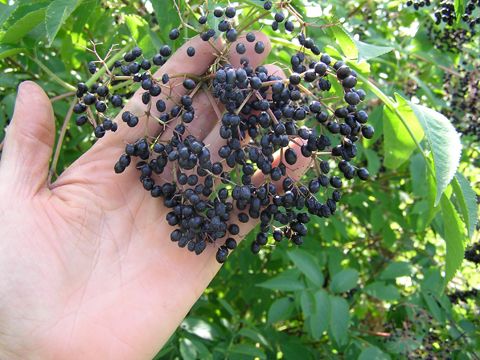 |
| Home | Ordering By Mail | Purchase Manual: Using Native Plants in Urban Landscapes |
|
|||||
Species Name: Sambucus canadensis
Common Name: Black elderberry
Zone: 4 to 9
Distribution: southern Nova Scotia and Quebec in the north, south to Florida and Texas
Seed collection: Black elderberry matures in late August and early September. Fruit changes from green to a deep purple to black color. Fruit is produced in large flat-topped clusters and matures over a two to three week period in the same order of flowering. Strip fruits from the clusters or remove the entire clusters for processing.
Seed handling: Fruits are quite small and the seeds even smaller. Each fruit holds from one to a couple of small seeds. Fruits can be stripped from the clusters by hand, rubbed over a screen or fruits and clusters can be macerated in a food processor for cleaning. The tiny hard seed will not be damaged by the blade. Process seed until the pulp and skins are pureed. Float off the pulp, skins and any seeds that float in several changes of water. Sound seeds will sink to the bottom. The seed is tiny but even small amounts of fruit produce large numbers of seed. Place cleaned seed under moist stratification to maintain moisture content. Cleaned seed can be sown immediately in prepared beds, planted outdoors under natural conditions or stratified for storage. Cleaned seed can be stored under cold moist conditions for up to two years.
Germination requirements: Elderberry seed requires a few weeks to a month of warm temperatures followed by two to three months of cold to break dormancy. Seed also has an impermeable seed coat that must be broken to imbibe water. Cleaned seed can be warm/moist stratified and then cold/moist stratified for spring planting or fall sow and let natural temperatures satisfy the temperature requirements. Seed germination is very erratic but seed is so abundant that even a low germination percentage produces a large number of seedlings. Seed will continue to germinate over several years. Cleaned seed can be sown immediately in prepared beds, planted outdoors under natural conditions or stratified for storage. Uncleaned seed can be broadcast in suitable habitat. Seedlings are small and develop slowly at first but growth increases once a root system is established.. Young seedlings cannot tolerate much vegetative competition when small.
Cutting Propagation: It is worth noting that elderberry is extremely easy to propagate from root cuttings. Remove a section of root from the plant from a few inches to several inches long or remove a section of root with a shoot attached and replant with the root piece horizontal to the ground. A new shoot will emerge from the root section. This is how elderberry naturally spreads. When removing a section of root with a stem attached cut the stem back to a few inches in length, the shoot will regrow. Root cuttings will produce a mature plant more rapidly than starting from seed. Root cuttings can be taken from early spring through mid summer as long as the plant has time to establish a new root system before winter.
Elderberry fruit ready for harvest.
this page posted November 1, 2011